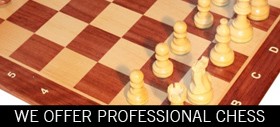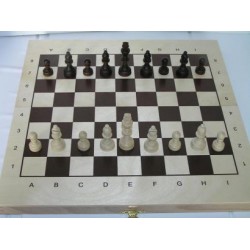No products
OCTONOVEM Games Set
OCTG48
New product
Angulus Angulus is the Latin word for angle. The aim of the game is to eliminate the opponent's king from the chessboard. The capturing is not obligatory. On the square of the captured opponent's chessman we put our chessman.
- Write a review
More info
Angulus Angulus is the Latin word for angle. The aim of the game is to eliminate the opponent's king from the chessboard. The capturing is not obligatory. On the square of the captured opponent's chessman we put our chessman. It is mandatory to warn the opponent when you make a move that puts the other player in check. Pawns can move and capture only one square at the time. The pawns move horizontally, vertically and diagonally, but they capture only diagonally. When the pawn reaches the opponent's side of the board, it is transformed into a piece. However the maximum quantity of pieces is four for each player. If the number of the pieces is four, the pawn will be transformed into a piece only on condition, that we lose one of the pieces and when the pawn is still on the edge of the board. The initial position of chessmen Pieces move and capture horizontally, vertically or diagonally one or two squares at the time. King move and capture horizontally, vertically or diagonally one, two or three squares at the time. Basileus Basileus is the Latin word for king. The aim of the game is to eliminate the opponent's king from the chessboard. The capturing is obligatory and can proceed in multiple jumps. It means that we must leap over all the opponent's chessmen on our way in one move. One can choose the direction of the capturing. Pawns: move diagonally in all directions, one square at the time. capture the opposing chessman by jumping over it to the nearest square of the same colour. To do this they can move to the left or to the right, forwards or backwards, but not diagonally. can capture only another pawns or basileus. Pieces: move diagonally in all directions, one square at the time. capture the opposing chessman by jumping over it to the nearest square of the same colour. To do this they can move only diagonally in all directions. can capture only another pawns or basileus. The initial position of chessmen: pawn, piece, pawn, piece, basileus, piece, pawn, piece, pawn Basileus: moves horizontally, vertically or diagonally in all directions one square at the time. captures the opposing chessman by jumping over it to the nearest square of the same colour. captures horizontally, vertically or diagonally in all directions. can capture only pawns and pieces in multiple jumps cannot jump over the opponents basileus in a multiple jump. If it finally stops on a square next to the opponents basileus (when there is not a possibility to go further to capture chessmen), then the opponent in the next movement, if it is possible, can capture basilieus by jumping over it. Prosterno Prosterno is the Latin word for knock down or prostrate. The aim of the game is for one of your pawns to reach the opponents side of the board. The pawns can move only diagonally, one square at a time forwards in two directions. They can move diagonally backwards only if they attack the opponent's pawn. When the pawns are in adjacent squares with one or more of the opponent's pawns, then: The pawn under attack must jump horizontally or vertically over an empty square to the next square of the same colour behind it, but should remain on the same straight line as the attacking pawn. If the pawn cannot escape to the second square (because it is already occupied or if it is at the edge of the board), it is taken off the board. If the escape brings the escaping pawn into contact with an opponents pawn, it must attack it in the same move. Nubulus Nubulus is the Latin word for cloud. The aim of the game is for one of your pawns to reach the opponents side of the board. The pawns can only move forwards, left or right, one square at a time, changing the colour of the square. The capturing is obligatory and can proceed in multiple jumps. It means that we leap over all the opponent's pawns on our way in one move. The pawns captures only diagonally in four directions, A pawn making a capturing move leaps over one of the opponent's pawns to the nearest square of the same colour, when the square is not occupied by another pawn. The capturing takes place in the next movement after the pawns get in touch, as it is in draughts. One can choose the direction of the capturing. Captured pawns are removed from the chessboard. Author of those games is Marek Łukaszewicz
Reviews










